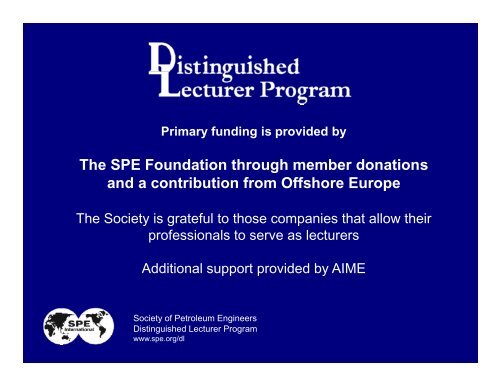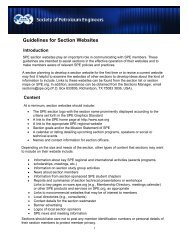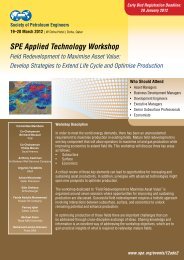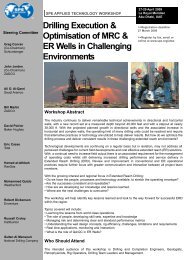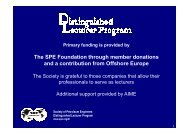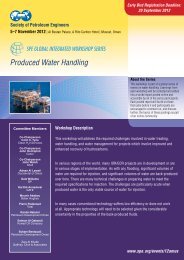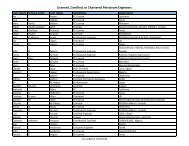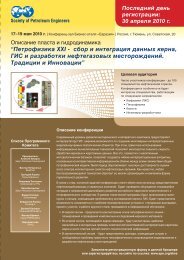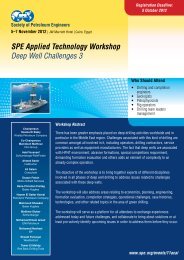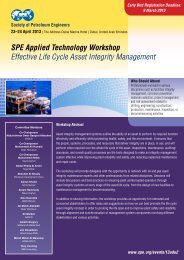How to Strengthen and Stabilize the Wellbore during Drilling ...
How to Strengthen and Stabilize the Wellbore during Drilling ...
How to Strengthen and Stabilize the Wellbore during Drilling ...
Create successful ePaper yourself
Turn your PDF publications into a flip-book with our unique Google optimized e-Paper software.
Primary funding is provided by<br />
The SPE Foundation through member donations<br />
<strong>and</strong> a contribution from Offshore Europe<br />
The Society is grateful <strong>to</strong> those companies that allow <strong>the</strong>ir<br />
professionals <strong>to</strong> serve as lecturers<br />
Additional support provided by AIME<br />
Society of Petroleum Engineers<br />
Distinguished Lecturer Program<br />
www.spe.org/dl
<strong>How</strong> <strong>to</strong> <strong>Stabilize</strong> <strong>and</strong> <strong>Streng<strong>the</strong>n</strong> <strong>the</strong><br />
<strong>Wellbore</strong> <strong>during</strong> <strong>Drilling</strong> Operations<br />
Dr. Fred Growcock<br />
Society of Petroleum Engineers<br />
Society of Petroleum Engineers<br />
Distinguished Lecturer Program<br />
www.spe.org/dl
Presentation Outline<br />
‣ The Lost Circulation Problem<br />
‣ Strategy for Managing Lost Circulation<br />
‣ <strong>Wellbore</strong> <strong>Streng<strong>the</strong>n</strong>ing<br />
‣ <strong>Wellbore</strong> Stress Enhancement<br />
‣ Application Strategies on <strong>the</strong> Rig<br />
‣ Case His<strong>to</strong>ry<br />
‣ Summary<br />
3
The Lost Circulation Problem: High-Risk Operations<br />
Fractured <strong>Wellbore</strong><br />
Pressure Gradient / Mud Density<br />
Frac Gradient<br />
Mud Weight<br />
Stable <strong>Wellbore</strong><br />
Collapsed <strong>Wellbore</strong><br />
Mud<br />
Weight<br />
Weak zone (depleted)<br />
0 30 60 90<br />
Well Inclination<br />
Deviated <strong>Wellbore</strong>s<br />
Pore<br />
Pressure<br />
Depleted Zones<br />
Deep Water
The Lost Circulation Problem<br />
• Estimated industry cost in <strong>the</strong> Gulf of Mexico:<br />
$1 billion/yr. Worldwide: ~ $ 2 <strong>to</strong> 4 billion/yr.<br />
• On average, 10-20% of <strong>the</strong> <strong>to</strong>tal cost of drilling an<br />
HTHP well is expended on mud losses (U.S.<br />
Department of Energy).<br />
• No consistent approach <strong>to</strong> manage lost circulation.<br />
• Nearly 200 products offered by 50 drilling fluid<br />
companies <strong>to</strong> control lost circulation.<br />
A comprehensive Lost Circulation mitigation <strong>and</strong><br />
prevention program is required.<br />
5
Managing Lost Circulation: A 4-Tiered Strategy<br />
6
Tier I. Best Current or New<br />
‣ Accurate, precise Geomechanics Model, esp.<br />
Pore Pressure / Fracture Gradient<br />
‣ Minimum <strong>and</strong> invariant Equivalent Circulating<br />
Density (ECD)<br />
• Accurate hydraulics profile for pre-drilling & at well site<br />
• Good hole-cleaning gpractices<br />
• Optimized solids control equipment<br />
‣ Managed Pressure <strong>Drilling</strong><br />
‣ Casing While <strong>Drilling</strong><br />
‣ Exp<strong>and</strong>able Casing/Liner<br />
7
Managing Lost Circulation: A 4-Tiered Strategy<br />
8
Tier II. which Minimize Losses:<br />
WBM:<br />
Full pressure shielded from tip by<br />
solids filter cake buildup.<br />
OBM/SBM:<br />
Full pressure at fracture tip.<br />
based on Morita et al, SPE 20409
Tier II. which Minimize Losses:<br />
‣ High Low-Shear-Rate Viscosity (LSRV)<br />
Reservoir Fluids<br />
Underbalanced Fluids<br />
Aphron <strong>and</strong> Mixed Metal Fluids<br />
‣ Minimum <strong>and</strong> Invariant ECD<br />
Soluble or Micronized Weighting Material<br />
Temperature-Insensitive Rheology<br />
‣ <strong>Wellbore</strong> Isolation<br />
Silicate, Gilsonite Fluids<br />
10
Managing Lost Circulation: A 4-Tiered Strategy<br />
11
Tier IV. in Pills or Whole Mud<br />
Contingency: losses in high-perm zones/fractures<br />
‣Blends of materials of<br />
different sizes, shapes<br />
<strong>and</strong> properties;<br />
‣Particle size distribution<br />
matches distribution of<br />
openings in rock;<br />
‣Used in squeeze or<br />
sweep treatments;<br />
‣May be used one time<br />
or on regular basis<br />
while drilling ahead.<br />
ize Distribution<br />
Cumulative Particle-S<br />
1.0<br />
0.9<br />
0.8<br />
0.7<br />
0.6<br />
0.5<br />
0.4<br />
0.3<br />
0.2<br />
0.1<br />
Optimum Bridging Agent Blend for Fluid<br />
0<br />
1x10 -2 1x10 -1 1x10 0 1x10 1 1x10 2 1x10 3 1x10 4<br />
Particle Size (microns)<br />
12<br />
D10 T<br />
D50 T<br />
D90 T<br />
F<br />
Br<strong>and</strong><br />
Mud<br />
A=Pu<br />
B=Pu<br />
C=Sn<br />
D=Om<br />
Calc<br />
Avg<br />
Max
Managing Lost Circulation: A 4-Tiered Strategy<br />
13
vs<br />
Flakes<br />
Insoluble Salts<br />
Most Fibers<br />
Marble<br />
Syn<strong>the</strong>tic<br />
Graphite<br />
Plates<br />
Laminates<br />
Hard,<br />
Granular<br />
Fibers<br />
Swellable or<br />
Reactive<br />
Materials<br />
Soft Granules<br />
14
Strategies for <strong>Streng<strong>the</strong>n</strong>ing <strong>the</strong> <strong>Wellbore</strong><br />
• Physical<br />
– <strong>Wellbore</strong> Isolation: Swellable or Reactive Materials<br />
– Fracture Tip Isolation (Fracture Propagation Resistance)<br />
• Chemical<br />
– Decrease clay swelling pressure (inhibi<strong>to</strong>rs such as K+<br />
<strong>and</strong> invert emulsions)<br />
• Thermal<br />
– Increase temp of drilling fluid above bot<strong>to</strong>m-hole static<br />
temp: stiff formations, high <strong>the</strong>rmal expansion<br />
• Mechanical<br />
– Fracture Closure Stress<br />
– Hoop Stress Enhancement (Stress Cage)<br />
15
Leak‐Off<br />
Pressure<br />
(LOP)<br />
FBP after <strong>Wellbore</strong> <strong>Streng<strong>the</strong>n</strong>ing<br />
Original Formation Breakdown Pressure (FBP)<br />
Fracture Propagation Pressure (FPP)<br />
Fracture Gradient (FG)<br />
Pressure<br />
e<br />
Fracture Closure Pressure (FCP)<br />
(= Minimum Horizontal Stress, S hmin )<br />
Time or Vl Volume Pumped (constant pump rate)
Fracture Closure Stress<br />
• High-fluid-loss treatment for existing fractures<br />
• Applied as high-fluid-loss h id l pills or whole mud<br />
treatment (Drill-n-Stress)<br />
• Pill may be water-based in a non-aqueous<br />
system<br />
• May follow with cross-linked polymer plugs or<br />
cement
Fracture Closure Stress<br />
As existing fracture is widened,<br />
particles are forced deep within <strong>the</strong> fracture.<br />
Liquid leaks from <strong>the</strong> slurry<br />
through <strong>the</strong> fracture walls or tip.<br />
18
Fracture Closure Stress<br />
As <strong>the</strong> slurry deliquifies, it consolidates.<br />
The residual solid plug supports <strong>the</strong> fracture <strong>and</strong><br />
isolates <strong>the</strong> tip.<br />
19
Hoop Stress Enhancement<br />
• <strong>Wellbore</strong> is pre-fractured <strong>and</strong> sealed <strong>to</strong> prevent<br />
subsequent fracturing<br />
• Ma<strong>the</strong>matical models are used <strong>to</strong> design <strong>the</strong> :<br />
calculate <strong>the</strong> required fracture width <strong>and</strong> particle size<br />
distribution of<br />
• is added at moderate concentration while<br />
drilling (involves solids control management):<br />
Continuous addition is much more effective than pills<br />
• The formation is pressured every st<strong>and</strong> <strong>to</strong> build hoop<br />
stress, or ECD is raised <strong>to</strong> desired level
Hoop Stress Enhancement<br />
As fracture is widened, large particles are forced in<br />
<strong>and</strong> wedged in <strong>the</strong> fracture mouth <strong>to</strong> create bridge<br />
Smaller particles come in behind <strong>the</strong> bridge<br />
<strong>and</strong> seal <strong>the</strong> opening<br />
21
Hoop Stress Enhancement<br />
Trapped fluid filters<br />
through permeable walls of fracture<br />
The pressure drops <strong>and</strong> compressive<br />
forces are transferred <strong>to</strong> WSM<br />
22
Hoop Stress Enhancement Application Cycle<br />
Suitability of Treatment<br />
Data Collection<br />
Modeling of Fracture<br />
Creation <strong>and</strong> Filling<br />
Lessons Learned<br />
Output:<br />
-Fracture dimensions<br />
-Formulation of Loss<br />
Prevention Material<br />
Data Collected<br />
&<br />
Analyzed<br />
Program<br />
Implementation<br />
Fluids Program<br />
-Type of treatment:<br />
*Pills<br />
*Continuous<br />
-H<strong>and</strong>ling WSM<br />
-Fluid property management<br />
-Moni<strong>to</strong>ring <strong>to</strong>ols<br />
• Slot Tester<br />
• Sieves<br />
-Mud Pump restrictions<br />
-Downhole <strong>to</strong>ols restriction<br />
ti<br />
-Lost circulation contingency<br />
23
Design of Hoop Stress Enhancement<br />
• Fracture Width required <strong>to</strong> achieve desired<br />
wellbore pressure – elastic model:<br />
‣ Desired Equiv. Circ. Density, or <strong>Wellbore</strong> Pressure<br />
‣ Rock Properties – Poisson’s Ratio, Young’s Modulus,<br />
Minimum Horizontal Stress (or Fracture Gradient)<br />
‣ Well Geometry – Depth, Inclination, Hole Size<br />
• Acceptable types of WSM<br />
• WSM particle size distribution (PSD) <strong>and</strong><br />
concentration<br />
24
Acceptable<br />
Large, Tough <strong>and</strong> Granular<br />
25
Unacceptable<br />
26
Continuous Addition of <strong>to</strong> whole mud is best<br />
• For short intervals, bypass <strong>the</strong> shale shakers<br />
• For long intervals, screen out <strong>the</strong> WSM with <strong>the</strong> shakers<br />
• The most effective solution: an WSM Recovery System<br />
Screens out drilled cuttings<br />
Recovers <strong>and</strong><br />
recycles WSM<br />
Screens out fines<br />
27
Moni<strong>to</strong>ring Hoop Stress Enhancement<br />
• Techniques <strong>to</strong> be used at <strong>the</strong> rigsite:<br />
– Permeability Plugging g Tests<br />
– Wet Sieve Analysis<br />
– S<strong>and</strong> kit determination<br />
• Techniques available at shore bases:<br />
– Laser Light-Scattering Particle Size<br />
Distribution<br />
– Fracture Sealing <strong>and</strong> <strong>Wellbore</strong><br />
<strong>Streng<strong>the</strong>n</strong>ing tests<br />
28
eepwater Case His<strong>to</strong>ry Gulf of – Mexico, Deepwater Above Gulf <strong>and</strong> of Below Mexico<br />
Salt<br />
SALT<br />
<strong>Drilling</strong> ECD<br />
exceeds min<br />
Frac Gradient<br />
Major challenges<br />
• Mud losses…> 15,000 bbl/well<br />
on previous wells, especially in<br />
intervals below <strong>the</strong> salt!<br />
• <strong>Wellbore</strong> stability<br />
Solution<br />
• <strong>Streng<strong>the</strong>n</strong> five intervals<br />
- One above <strong>the</strong> Salt<br />
- One in <strong>the</strong> Salt<br />
- Three below <strong>the</strong> Salt<br />
• Shakers dressed with<br />
14/20 mesh screens<br />
• [WSM] ~ 15 <strong>to</strong> 30 lb/bbl<br />
• WSM Design<br />
- Sized Marble<br />
- Granular Syn<strong>the</strong>tic Carbons
Case His<strong>to</strong>ry – Deepwater Gulf of Mexico<br />
No losses in 2900 ft s<strong>and</strong> section above salt<br />
No losses in 7500 ft salt section, screened up<br />
No losses in 9200 ft s<strong>and</strong> section below salt<br />
(where majority of losses occurred in offset wells)<br />
Savings<br />
• Total cost for <strong>the</strong> WSM ~ $ 0.7 MM. Previous mud<br />
losses ~ $ 2.7 MM. Net savings ~ $ 2.0 MM on<br />
materials alone.<br />
• On subsequent 4 wells, similar net savings of ~ $ 2.0<br />
MM on materials alone.
Summary<br />
The 4-tier strategy for managing lost circulation<br />
must be an integral part of well planning<br />
31
Your Feedback is Important<br />
Enter your section in <strong>the</strong> DL Evaluation Contest by<br />
completing <strong>the</strong> evaluation form for this presentation or<br />
go online at:<br />
http://www.spe.org/events/dl/dl_evaluation_contest.php<br />
Society of Petroleum Engineers<br />
Distinguished Lecturer Program<br />
www.spe.org/dl<br />
32


